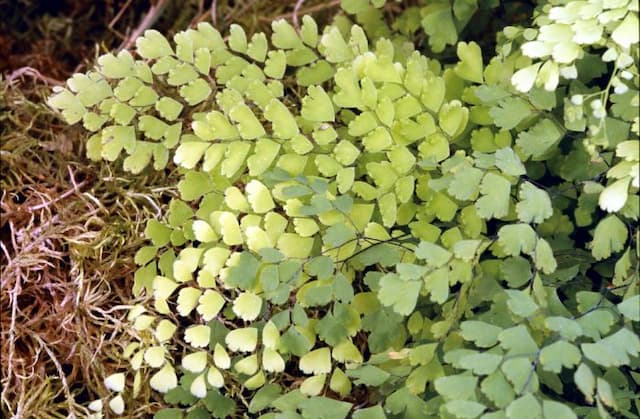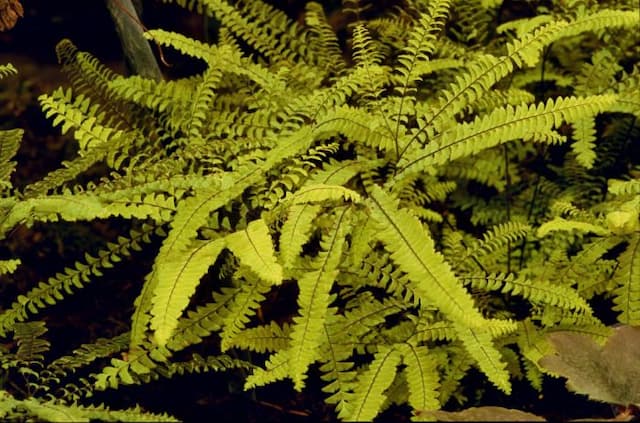Woolly Lipfern Cheilanthes tomentosa

ABOUT
The plant known most commonly as woolly lip fern is a perennial fern with an eye-catching appearance. Its fronds, which are the leaves of the fern, have a unique texture due to a dense covering of small hairs, giving them a woolly or fuzzy look. This plush coating serves to protect the fronds from excess sunlight and moisture loss, providing an adaptive advantage in its natural habitat. The fronds are divided in a pinnate fashion, meaning that the leaflets, or pinnae, are arranged on either side of a central stalk, much like the feathers of a feather. This gives the fern a delicate, feathery appearance. Each of these leaflets is also subdivided, leading to a complex, lacy texture that is characteristic of many ferns. The color of the leaves is typically a lush green, which may contrast with the rusty or golden hue of the hairs when the sunlight filters through the fronds. As with many ferns, the woolly lip fern unfolds its new fronds in a curled fashion, known as fiddleheads, due to their resemblance to the scroll of a violin. These immature fronds slowly unfurl as they mature, adding a sense of dynamism and grace to the plant's appearance. Often found in rock crevices or on cliff faces, the woolly lip fern has a rugged, yet delicate look. Its ability to thrive in such environments highlights the plant's intricate root system and adaptability, which is not immediately apparent from its gentle outward appearance.
About this plant
 Names
NamesFamily
Pteridaceae
Synonyms
Woolly Lip Fern, Hairy Lip Fern, Woolly Cloak Fern, Downy Maidenhair Fern, Yellow-stemmed Lip Fern, Tomentose Lip Fern
Common names
Allosorus tomentosus, Cheilanthes lanuginosa, Cheilanthes lanosa, Cheilanthes micropteris, Hemionitis tomentosa, Pellaea tomentosa, Pellaea lanuginosa.
 Toxicity
ToxicityTo humans
The plant commonly known as woolly lip fern (Cheilanthes tomentosa) is not widely documented as toxic to humans. However, it is always important to exercise caution and not ingest plants without verified safety information. There is no well-documented evidence of poisoning from ingestion of this plant in humans, thus no specific symptoms of toxicity can be provided.
To pets
Similar to the information for humans, the woolly lip fern (Cheilanthes tomentosa) does not have a well-documented history of being toxic to pets. Pets should not consume plants that are not confirmed to be safe, but there is no specific information on symptoms of poisoning from this fern for pets, as occurrences are not well-reported in veterinary literature.
 Characteristics
CharacteristicsLife cycle
Perennials
Foliage type
Evergreen
Color of leaves
Green
Height
1 foot (0.3 meters)
Spread
1 foot (0.3 meters)
Plant type
Herb
Hardiness zones
8
Native area
Americas
Benefits
 General Benefits
General Benefits- Ornamental value: The Woolly Lipfern provides aesthetic value to gardens and natural landscapes due to its distinctive feathery fronds and attractive appearance.
- Drought tolerance: Being a fern adapted to arid conditions, it is particularly suited for xeriscaping or gardens in dry climates, requiring minimal water once established.
- Soil erosion control: It can be used to stabilize soil in rocky or sandy areas, reducing the risk of erosion.
- Habitat enrichment: The plant can serve as habitat and provide cover for small wildlife and beneficial insects.
- Low maintenance: It typically requires little maintenance, making it a convenient choice for gardeners of all skill levels.
- Shade tolerance: As a fern, the Woolly Lipfern can tolerate lower light conditions, making it suitable for shaded gardens or understory plantings.
 Medical Properties
Medical Properties- Antibacterial: Cheilanthes tomentosa may possess compounds that help to inhibit the growth of certain bacteria.
- Antioxidant: Compounds in the plant could offer protection against oxidative stress by neutralizing free radicals.
- Anti-inflammatory: There may be properties within the plant that help in reducing inflammation in the body.
 Air-purifying Qualities
Air-purifying QualitiesThis plant is not specifically known for air purifying qualities.
 Other Uses
Other Uses- Cheilanthes tomentosa, commonly known as Woolly Lip Fern, can be used in terrariums and vivariums due to its size and adaptability to humid environments, making it an attractive, low-maintenance addition.
- It can act as a natural insulator when planted in dense patches, providing a barrier against temperature fluctuations in the immediate microenvironment.
- The fibrous root system of the Woolly Lip Fern can help in soil stabilization on slopes and prevent erosion in areas prone to heavy rains.
- This fern can also be used in xeriscaping, which involves creating landscapes that reduce or eliminate the need for watering, due to its ability to withstand dry conditions once established.
- As a natural indicator of a non-polluted environment, the presence of the Woolly Lip Fern can signal good air quality in the immediate vicinity.
- Use the fern in floral arrangements as a green filler because of its delicate and textured fronds which contrast well with bright flowers.
- The plant can serve as a companion plant in gardens, fostering a more suitable microclimate and providing shade for more delicate, shade-loving ground covers.
- When dried, the fronds of the Woolly Lip Fern retain their shape and color, making them an ideal choice for use in dried floral compositions and crafts.
- Enthusiasts of miniature gardening and fairy gardens favor the Woolly Lip Fern for its fine texture and fairy-tale aesthetic.
- The leaves of the Woolly Lip Fern can be used as a natural green dye for fabrics, providing a moderate and sustainable source of color.
Interesting Facts
 Feng Shui
Feng ShuiThe Woolly Lip Fern is not used in Feng Shui practice.
 Zodiac Sign Compitability
Zodiac Sign CompitabilityThe Woolly Lip Fern is not used in astrology practice.
 Plant Symbolism
Plant Symbolism- Resilience: Cheilanthes tomentosa, commonly known as Woolly Lipfern, often grows in rocky, arid environments, embodying the ability to thrive in challenging conditions.
- Adaptability: Woolly Lipfern has the capacity to adapt to different habitats, symbolizing versatility and the ability to adjust to various circumstances in life.
- Protection: The woolly texture of Woolly Lipfern's fronds can be seen as a form of natural protection against desiccation, representing safety and shelter.
- Subtlety: With its delicate appearance, Woolly Lipfern exemplifies the beauty in the understated, encouraging an appreciation for subtle elegance.
 Water
WaterThe woolly lip fern should be watered moderately, allowing the top layer of soil to dry out slightly between watering sessions. It's best to water this plant once every 1-2 weeks, depending on the environmental humidity and temperature. Use lukewarm water and aim to evenly moisten the soil without waterlogging it. For an average-sized plant, watering with approximately 8-16 ounces of water should be sufficient. During winter months, reduce watering frequency as plant growth slows down.
 Light
LightThe woolly lip fern thrives best in partial shade to full shade conditions. It should be placed in a spot that mimics its natural habitat, such as the dappled light under a tree canopy or in a north-facing windowsill that doesn't receive direct sunlight. Avoid exposing the fern to direct sunlight, as this can scorch its leaves and cause stress to the plant.
 Temperature
TemperatureThe woolly lip fern prefers temperature conditions that are moderate to warm, with ideal temperatures ranging from 60 to 75 degrees Fahrenheit. It is important to avoid temperatures below 50 degrees Fahrenheit, as cold temperatures can be damaging to the plant. Ensure that the woolly lip fern is kept away from drafts and sudden temperature changes to maintain a consistent growing environment.
 Pruning
PruningFor the woolly lip fern, pruning is mainly done to remove dead or damaged fronds and to maintain a tidy appearance. Prune the plant as needed, typically once or twice a year. The best time for pruning is in the spring or early summer, when the fern begins its new growth cycle. Cut fronds at the base, close to the soil line, using clean and sharp scissors or pruning shears.
 Cleaning
CleaningAs needed
 Soil
SoilThe Woolly Lipfern thrives in a well-draining soil mix with a slightly acidic to neutral pH of 6.0 to 7.2. An ideal soil mix consists of one part peat, one part perlite or pumice, and one part loamy soil to promote good aeration and moisture retention without becoming waterlogged.
 Repotting
RepottingWoolly Lipfern should be repotted every 2 to 3 years or when it has outgrown its current container. Spring is the best time to repot to minimize stress and allow for vigorous growth during the growing season.
 Humidity & Misting
Humidity & MistingWoolly Lipfern prefers moderate to high humidity levels, around 40-50%. Mist regularly or place in a humidified room to maintain these levels for optimal growth.
 Suitable locations
Suitable locationsIndoor
Place Woolly Lipfern in bright, indirect light and maintain humidity.
Outdoor
Grow Woolly Lipfern in dappled shade and protect from harsh sun.
Hardiness zone
7-10 USDA.
 Life cycle
Life cycleCheilanthes tomentosa, commonly known as woolly lip fern, begins its life cycle as a spore, which germinates in a suitable environment to form a small, heart-shaped gametophyte (prothallus). The gametophyte houses both male and female reproductive organs, and when conditions are favorable, it produces sperm that swim to fertilize the eggs, leading to the development of a new sporophyte. This marks the transition from the gametophyte to the sporophyte stage, which is the vegetative and more commonly recognized fern plant. The sporophyte grows through the juvenile phase, where it develops its characteristic woolly fronds. As the fern matures, these fronds produce sori on their undersides, clusters of sporangia that eventually release spores, thus completing the life cycle when these spores disperse to begin the cycle anew. The woolly lip fern thrives in well-drained, rocky soils and can reproduce both sexually through spores and vegetatively by rhizome division, although spore production is the primary mode of propagation.
 Propogation
PropogationPropogation time
Spring to Summer
Propogation: The woolly lipfern, or Cheilanthes tomentosa, is typically propagated through spore cultivation, which is the most popular and effective method for many fern species. The process begins when ripe spores, which are typically collected in the summer months when they are most abundantly produced, are sown onto the surface of a sterilized, moistened propagation medium, such as a mix of peat and perlite. This environment should be kept humid by covering it with a clear plastic wrap or a glass pane to maintain moisture yet still allow light penetration, which is essential for germination. It's important not to bury fern spores as they require light to germinate. In a few weeks to a few months, given proper warmth and light conditions, the spores will germinate, producing tiny, heart-shaped gametophytes, which will eventually give rise to the new fern sporophytes. Throughout this process, avoid letting the medium dry out, but also avoid waterlogging, which can lead to fungal infections and rot.




